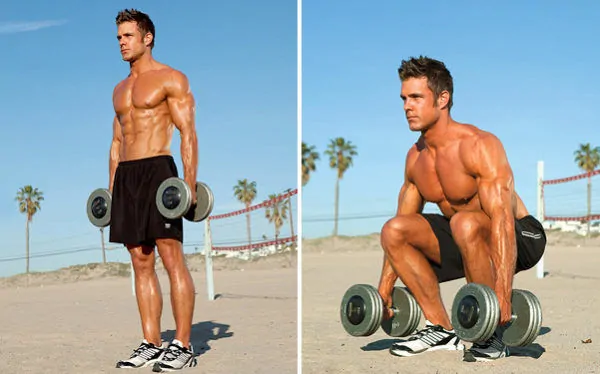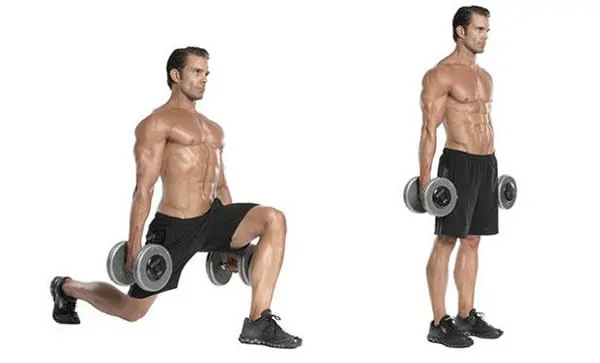Many athletes value a muscular upper body and neglect the lower area. Well-shaped and trained legs are very important for the overall impression.
Not only a proudly arched breastplate and washboard belly should be on your to-do list. You should also always include your legs when training at home. Not only that slender stilts do not match the muscular rest visually at all. Our legs also carry us through life every day. The stronger they are, the easier it is for us. Not to forget the visual advantages of well-shaped legs. We show you how you can optimally build up the leg muscles at home.
The leg muscles
Which muscles ensure well-formed legs?
The biggest powerhouse is the four-headed thigh muscle called Quadriceps femoris on the front of the thigh. Its four individual muscles allow extension in the knee joint. The internal muscle portion is particularly important because it contributes significantly to the stabilization of the joints. On the back is the ischiocrural muscles, which consist of the two-headed thigh muscle (biceps femoris), the semi-tendon muscle (semitendinosus) and the flat tendon muscle (semimembranosus). All three act as hip extensors and knee bends. The lower leg muscles consist of the three-headed calf muscle (Triceps surae), the twin calf muscle (Gastrocnemius) and the plaice muscles, called the soleus. The gastrocnemius, in particular, acts as a strong flexor in the ankle and has a stabilizing effect on the knee joint.
The training principles
How can I optimally train my legs?
There are a few principles to consider when training: The main part of your workout should consist of multi-joint and compact exercises. As a beginner, six exercises are usually enough. Two of these should train the leg muscles. Two to three training sessions on nonconsecutive days are ideal. The three-sentence method has proven to be particularly effective in studies. In other words, you do three sets per exercise with 12 to 15 repetitions and a break of about 60 seconds in between. The load is optimal when the last repetition is trying, but you are still doing it technically correctly. After six to eight weeks of regular training, you can increase the load and train to muscle exhaustion. But even then a technically correct movement is important. It is ideal when you alternate between exhausting and less exhausting workouts. Professionals can train with up to 90 percent of the maximum strength. Then 3 sets of 4 to 8 repetitions are ideal.
The toolsВ В
What equipment can I use to optimally train my legs?
You have two options for training at home: training with free weights and training at multi-gyms. For your leg training both dumbbells and kettlebells very suitable. The advantage of free weights: the movements correspond to the everyday movements and they are more effective because more muscles are used. However, they are also somewhat more difficult to carry out. Even small changes in the movement sequence can activate completely different muscles. Therefore, training in front of the mirror or with a training partner is recommended. Training at a multi-gym is easier from the sequence of movements. You choose the weight you want and do your exercise. They are therefore particularly suitable for beginners. But professional athletes also train at power stations from time to time, because they can be used to precisely dose the weight.
The leg muscle exercises
Which exercises do muscular legs?
The most effective exercise to build up the leg muscles is the squat, also called squats exercise. You can do it in different variations and with different tools. We will introduce many of them to you below. Calf lifting is very effective and essential for muscular calves. You can also train the individual leg muscles in a largely isolated manner at an appropriately equipped multi-gym. Here, too, we will introduce you to a few exercises.

Leg training for beginners
What exercises do I use to build muscle?
Squats with dumbbells
Exercises the quadriceps femoris and the glutes
You take a dumbbell in each hand and hold it next to your body with your arms outstretched. Then you lower your buttocks with your back straight, up to a 90-degree angle in your knees. Hold briefly and push up again without fully extending your knees.
Squats with barbell
Exercises the quadriceps femoris and the glutes
You put the barbell on your shoulders behind your head and stand hip-width apart. The feet point slightly outwards. This allows the knees to follow the feet anatomically correctly. Then tighten your abdominal and buttock muscles and squat with your back straight up to a 90-degree angle. Hold briefly and then stretch again without fully pressing your knees.
Squats with kettlebell
Exercises the quadriceps femoris and the glutes as well as the back extensor
Grasp the spherical part of the kettlebell from below with both hands and hold the weight in front of your chest. You stand a little more than your waist and your feet point slightly outwards. Then you crouch in a controlled position with your back straight. The knees point towards the tip of the foot. Then press up again in a controlled manner without going into full extension.
One-legged squat
Trains the quadriceps femoris, the glutes, and the hamstrings
The one-leg squat is also highly effective. You can also do this exercise with dumbbells, barbell, and kettlebell. You hold dumbbells on the right and left side of your body. You put the barbell on your shoulder behind your head. You take the kettlebell from below with both hands and hold it in front of your chest. The basic exercise then looks like this:
You step into the lunge, the chest is raised, the view is forward and the weight is on the front leg. Then slowly bend your knees and hips, with the front knee not protruding beyond the toes. You lower the back knee almost to the floor. Then slowly stretch again.
Calf raises
Trains the two-headed calf muscle and the clod muscle
Another exercise that you can do with dumbbells, barbell or kettlebell. You take the dumbbells and kettlebell in your right and left hand, you put the barbell on your shoulder behind your head.
Stand with the balls of your feet on a stable platform or a step board. Your body is very straight. Then you raise both heels as high as possible, hold them briefly and lower them again.
Leg bends at the multi-gym
Trains the hamstring
Depending on the multi-gym, you can do leg bending while sitting or prone. The exercise is self-explanatory, the multi-gym dictates the movement. Controlled and not jerky movements are important. Try to keep tension.
Leg extensions at the multi-gym
Exercises the Quadriceps femoris
With this sitting exercise, you can train quadriceps, one of the largest muscle groups in the body, in isolation. This exercise is self-explanatory as the multi-gym dictates the movement.
Advanced leg training
How can I train my legs even better?
The following exercises are a little more difficult. They either strain even more muscle groups or you have to try to keep your balance at the same time in some exercises.
Front squat with a barbell
Trains the quadriceps femoris, the glutes, and the hamstrings
In this exercise, the barbell rests on the shoulders at the front. You stand upright and a little more than the width of your hips, your feet point slightly outwards. Then raise your chest and then, with your back straight, squat until your thighs are parallel to the floor. Hold briefly and press up again in a controlled manner.
Bulgarian squat with dumbbells or barbell
Trains the quadriceps, the glutes, the hamstrings, the two-headed calf muscle, and the clod muscle
For this exercise, you need a low bench or a step in front of which you stand with your back. If you work with dumbbells, take them in both hands and hold them on the side of your body. You place the barbell bar behind your head on the shoulders. Then you bring one leg back and place the toe on the bench or step. From this position, slowly lower the back knee until the front thigh is parallel to the floor. Hold briefly and push up again. Change legs after each set.

Lunge to the side with dumbbell or kettlebell
Trains the quadriceps femoris, the hamstrings, and the two-headed calf muscle
You stand upright and hold the dumbbells or kettlebells at chest height. Then you take a big step aside with one leg, keeping your torso straight. The knee of the straight leg must not protrude beyond the toes. The thigh of the bent leg is parallel to the floor. Then return to the starting position. Switch side.
Climbing stairs with dumbbells, kettlebells or barbells
Trains the quadriceps femoris, the Promifen en venta hamstring, the gluteal muscles, the two-headed calf muscle, and the clod muscle
You will need a weight bench, a fixed stool or another stable raised platform for this exercise. You stand in front of the bench and then put your left foot on the bench. It is ideal if the thighs and lower legs form a right angle. Then you press the left heel into the bench, tighten the thigh and buttock muscles, push yourself up and put your right foot on the bench. Then you step off the bench with your right leg. Switch side.
Seated calf raises with barbell
Above all trains the clod muscle
You sit on a weight bench or a stool and place a sufficiently heavy barbell on the front of your thigh. You then push this up by moving your heels up.
Leg Training for professionals
Which leg exercises are suitable for professionals?
If you have been exercising for a long time and have a lot of leg strength, you may be looking for exercises that are particularly challenging. So here are three exercises for professionals:
Hackenschmidt squat with a barbell
In particular trains the quadriceps femoris, but also glutes and hamstrings
You take the barbell in the upper handle and guide it upwards behind your body in an upright position. The feet are shoulder-width apart and are slightly turned outwards. Then you squat by slowly lowering the barbell behind your body. You bend your knees so that your thighs are parallel to the floor. The back is straight, the bottom is stretched out to the rear. Then stand up again.
Lunge with a barbell over your head
Trains the quadriceps femoris, the glutes, the hamstrings, the deltoids, and the back extensor
This exercise is very demanding because you have to keep your balance at the same time. You stand upright, your feet hip-width apart. Guide the barbell upwards in the wide top grip, bend your elbows slightly. Then, with your core muscles tense, step forward with one leg until the back knee almost touches the floor. Hold briefly, then shift the weight onto the back leg and return to the starting position.
Deadlift with barbell
Trains the glutes, the hood muscles, the back extensors, the straight abdominals, the hamstrings, and the quadriceps femoris
The highly effective exercise that is also part of powerlifting. The barbell is under your feet in front of you. You take the barbell bar more than shoulder width in the change handle. Then lift the dumbbell by pressing your legs firmly into the floor and stretching your knees and hips. The back is very straight. Go up to the level, then lower the weight in a controlled manner. Change handle.
